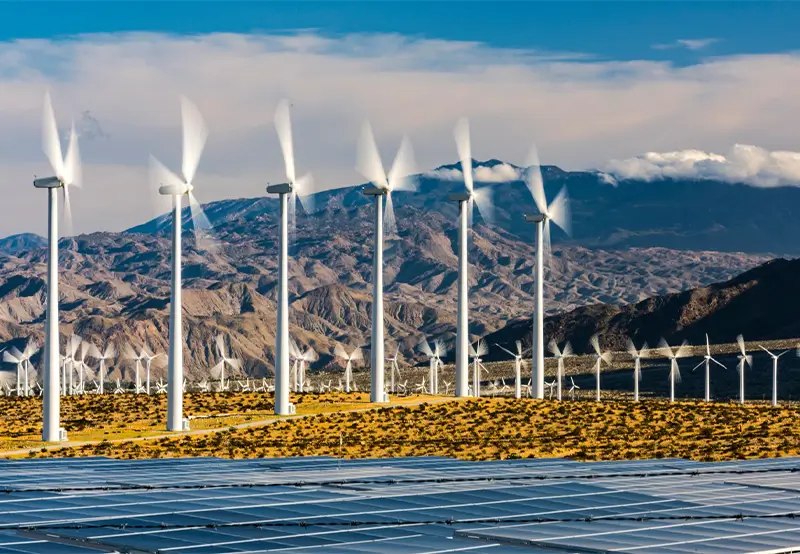Wind and Solar Power Surpass Coal in the US
The United States has reached a historic turning point in its energy sector: wind and solar power have overtaken coal for the first time, marking a crucial step in the clean energy transition. This transition comes out to show the increased superiority of the renewable sources of energy and the capacity they have to define the future of electricity production. The shift out of fossil fuels is happening at lightning speed with the advances in technology, policy and growing demand amongst the population to find sustainable ways of dealing with our energy needs.

The Decline of Coal in the US Energy Sector
Coal was the mainstay of the American energy sector for more than a century. However, a number of factors, such as changes in policy, environmental concerns, and economic shifts, have been gradually undermining its dominance. An important milestone that reflects the shifting energy landscape was reached in 2023 when wind and solar energy combined to provide more electricity than coal.
How Much Coal Is Used in the US?
One of the world’s biggest consumers of coal has been the United States. As recently as 2007, almost half of the nation’s electricity was produced using coal. But by 2023, that percentage had fallen to about 20%, and more drops are anticipated. The growth of natural gas, developments in renewable energy technologies, and policies intended to lower carbon emissions are the main causes of this decline.
Coal Production in the US by Year: A Downward Trend
The production of coal in the United States has been in steady decline in the last two decades. The U.S. Energy Information Administration (EIA) indicates that coal production reached a record 1.17 billion short tons in 2008 but fell to slightly more than 500 million short tons in 2023. The precipitous fall is due to power plant shutdowns, falling demand, and growing preference for cleaner sources of energy.
The Rise of Wind and Solar Power
Recent technological advancements, government subsidies, and declining costs have all contributed to the exponential growth of wind and solar energy. Now, when combined, these two renewable energy sources produce a higher percentage of electricity than coal, demonstrating that a sustainable energy future is achievable.
Future of Solar Energy in the US
Solar energy has seen record growth, with installed capacity growing over 30 times since 2010. Photovoltaic (PV) technology improvement and decreasing costs have been making solar electricity increasingly an appealing source of energy for utility-scale, commercial, and residential projects. The prospects for solar energy in the future are bright, with analysts forecasting sustained growth, growing efficiency, and universal application across all fronts.
Future of Wind Energy: A Key Player in the Energy Mix
Another important force behind the clean energy movement is wind power. Several of the biggest wind farms in the world are located in the United States, and the sector is expanding at a remarkable rate. The nation’s energy needs are anticipated to be met in large part by wind energy in the future thanks to investments in offshore wind projects and developments in turbine technology.
Why Renewable Energy is the Future
There are several strong arguments for the move towards renewable energy:
- Environmental Benefits: Since wind and solar energy emit no emissions, they can help fight climate change and lessen air pollution.
- Economic Growth: Investment in sustainable technologies is still being stimulated by the renewable energy industry, which has produced thousands of jobs.
- Energy Independence: The United States improves its energy security and lessens its reliance on foreign energy sources by lowering its reliance on fossil fuels.
- Cost Competitiveness: Compared to coal and other fossil fuels, wind and solar power are now more affordable due to significant price reductions.
Wind and Solar Power Overtake Coal: What’s Next?
As wind and solar energy overtake coal, the US energy landscape will continue to shift. The pace will be decided by future policies, upgrades to grid infrastructure, and energy storage innovation. Although there are still challenges, the trajectory of renewables implies that the age of coal addiction is fading.
Conclusion: The Clean Energy Transition is Here
The breakthrough of wind and solar energy surpassing coal is a defining moment in the US energy landscape. As coal production falls, investment in renewables continues to rise, and the focus on sustainability strengthens, the future is certain: renewable energy is not merely a replacement option—it is the future. The issue no longer is if the US will go green, but how quickly it will do so.
As we go forward, the imperative is to continue to drive the deployment of solar and wind power, grid modernization, and a just transition for coal workers. Transitioning to renewables is not just an environmental imperative; it is an economic and social chance that will shape the future of energy in America.
Frequently Asked Questions (FAQs)
The United States consumed approximately 450 million short tons of coal in 2023, primarily for electricity generation. However, coal usage has significantly declined over the past decade due to the increasing adoption of renewable energy sources.
Renewable energy, including wind and solar power, is the future because it is sustainable, reduces carbon emissions, and lowers electricity costs over time. Unlike fossil fuels, renewables do not deplete natural resources or contribute to climate change. Additionally, advancements in technology and government incentives are making clean energy more affordable.
In 2022, for the first time, wind and solar power generated more electricity than coal in the US. This shift was driven by declining costs, federal incentives, state policies, and increased investment in clean energy infrastructure. The expansion of wind farms and solar installations has contributed to this milestone.
The future of solar energy in the US looks promising. Experts predict that solar capacity will continue to grow, supported by advancements in photovoltaic technology, battery storage, and increased affordability. The US government’s clean energy policies also promote widespread solar adoption for homes and businesses.
The future of wind energy is also bright, with offshore wind farms expanding and onshore wind turbines becoming more efficient. The US has significant wind potential, especially in the Midwest and coastal areas. As grid infrastructure improves, wind energy is expected to become a dominant power source.












